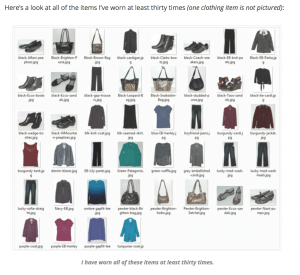Top tips to green your wardrobe
 Do you own about 70 garments? Do most of them last you less than a year? If so, you are about average for an American today. If you own half that number of garments and keep them for 3-5 years, you’re closer to the American average 15 years ago.
Do you own about 70 garments? Do most of them last you less than a year? If so, you are about average for an American today. If you own half that number of garments and keep them for 3-5 years, you’re closer to the American average 15 years ago.
This growth in clothing manufacture and use is no small thing. From the energy, water and pesticides used to the dyes and solvents in wastewater, making clothing can be a polluting business. With only about 15% of clothing donated for re-use, the waste adds up to tens of millions of tons in incinerators or landfills each year.
Changing this trend will take change in the industry. Manufacturers must find ways to use less toxic materials, conserve water and energy, and find ways to incorporate more recycled and renewable materials. Read more from an in-depth report from the Circular Fibres Initiative and Ellen MacArthur Foundation.
But even as industry makes changes, consumers can do their fair share, too. Here are OEC’s best recommendations to consumers:
Buy and sell thrift!
Reduce waste by bringing your unwanted clothing to the thrift store. Some of your clothes will continued to be worn, which has the best environmental benefit. Others will be recycled into rags, or fibers for use in insulation and other products. And you can keep an eye out for those durable, high-quality pieces to buy for yourself.
Buy less, wear longer
 Reducing your wardrobe to only the most enduring pieces is fine advice—but what does that actually look like? Check out this great “Recovering Shopaholic” blog in which author Debbie Roes takes a good, hard look at the “30 plus club” of items she’s likely to wear more than 30 times.
Reducing your wardrobe to only the most enduring pieces is fine advice—but what does that actually look like? Check out this great “Recovering Shopaholic” blog in which author Debbie Roes takes a good, hard look at the “30 plus club” of items she’s likely to wear more than 30 times.
Choose sustainably raised and processed natural fibers
Cotton, hemp, wool, alpaca, silk, jute, linen, flax, bamboo: these natural fibers will help you avoid the fossil-fuel-based materials and are a good choice for second-hand goods. Unfortunately, these materials may also need way too much water to raise (like cotton) or be processed with harsh chemicals (like linen and bamboo) or be non-vegan. When buying new, look for organic and other third-party certification that shows what care went into producing the clothing. Here are some certifications. And the problem with acrylic, as it turns out, is that it sheds micro-plastics that weave their way into the fabric of life itself. We haven’t tried this cora ball, a microfiber-catching laundry tool, but if you try it, please let us know how it works!
Avoid used PVC, stain- or water-resistant treatments when you can.
Some clothing continues to be a hazard as long as you use it. For example, outdoor gear and other rain and stain-resistant clothing may be made with PFCs: compounds that pollute our waterways and harm health. PVC is the leather-substitute plastic that can continue to release toxics even after it loses that “new baby doll” scent. Learn more about PFCs here.
Wash less often, in cold water
Your clothes will last longer, and you will conserve energy and water, if you don’t wash your clothing every time you wear it. When you do wash, using cold water will also reduce wear and save energy.
Demand safer products
When you do buy new clothing, it’s your chance to send the message to manufacturers that you value safe, durable and sustainable clothing. Look for proof of organic, sustainable processing and safer materials. The best proof is “third party” certification by an independent group. Here are examples.
Spotlight: Oregon’s Toxic Free Kids program
The Toxic Free Kids program requires manufacturers of children’s products, including clothes and shoes, to report on their use of toxic chemicals. Last year, manufacturers submitted more than 1400 reports on children’s clothes and shoes containing chemicals of concern. After the third reporting period, they will have to adopt safer alternatives. OEC is working with the Oregon Health Authority now to ensure that the rules for adopting safer alternatives are strong and put children’s health first.











John
February 23, 2019 (6:50 am)
Great article